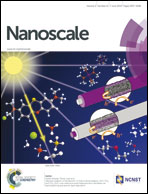Inorganic/organic hybrid solar cells: optimal carrier transport in vertically aligned silicon nanowire arrays†
Abstract
Inorganic/organic hybrid radial heterojunction solar cells that combine vertically-aligned n-type silicon nanowires (SiNWs) with poly(3,4-ethylenedioxythiophene):poly(styrene-sulfonate) (PEDOT:PSS) have great potential for replacing commercial Si solar cells. The chief advantage of such solar cells is that they exhibit higher absorbance for a given thickness than commercial Si solar cells, due to incident light-trapping within the NW arrays, thus enabling lower-cost solar cell production. We report herein on the effects of NW length, annealing and surface electrode on the device performance of SiNW/PEDOT:PSS hybrid radial heterojunction solar cells. The power conversion efficiency (PCE) of the obtained SiNW/PEDOT:PSS hybrid solar cells can be optimized by tuning the thickness of the surface electrode, and the etching conditions during NW formation and post-annealing. The PCE of 9.3% is obtained by forming efficient transport pathways for photogenerated charge carriers to electrodes. Our approach is a significant contribution to design of high-performance and low-cost inorganic/organic hybrid heterojunction solar cells.


 Please wait while we load your content...
Please wait while we load your content...